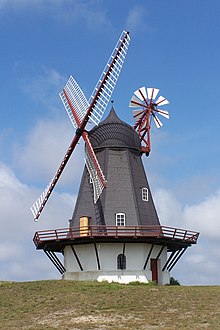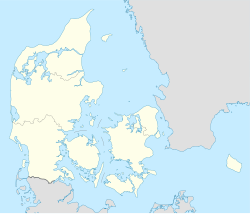| Esbjerg | ||
.jpg/250px-Esbjerg_harbour_(8563661696).jpg) | ||
| State | Denmark | |
|---|---|---|
| Region | Southern Jutland | |
| Altitude | 11 m a.s.l. | |
| Surface | 15 km² | |
| Inhabitants | 72.037 (Census 2020) | |
| Prefix tel | 45 7 | |
| POSTAL CODE | 6700-6715 | |
| Time zone | UTC 1 | |
Position
| ||
| Tourism site | ||
| Institutional website | ||
Esbjerg is a Danish city located in the region of Southern Jutland.
To know
With a population of 72,037 in the urban area surveyed in 2020, Esbjerg is the fifth largest city in the Denmark.
When to go
Esbjerg is characterized by an ocean-like climate, tempered by warm sea currents. Summers are relatively hot, given the high latitude, and winters are mild.
Background
Esbjerg was founded in 1868, following the loss of the port of Altona, which passed under German administration after the Danish defeat in the Second Schleswig War (1864). At the time Esbjerg consisted of only a few scattered farms but the urgent need for Denmark to have a merchant port on the North Sea that would guarantee the continuity of its exports to UK, caused Esbjerg to develop in a very short time. The port was officially inaugurated in 1874 and was already connected by rail to the centers of Varde and Fredericia. The 400 inhabitants registered at the beginning of 1870 had risen to 1,529 in 1880 and to 4,211 in 1890.
In 1893 Esbjerg became a separate municipality and in the following years it was equipped with modern infrastructures, including a court, an aqueduct, a gas plant (1896) and another for the production of electricity (1907).
From the beginning of the 20th century, Esbjerg prospered, becoming one of the country's main export centers and an important fishing port. In 1895 the city had nine dairies and a butter factory, the "Dansk Andels Smørpakkeri" which initially employed about 150 workers, but which soon expanded to include another 140 factories which exported most of their production to the UK. Other companies also arose operating in the most diverse sectors of food packaging, almost all directed to the market of UK.
Even today, the port of Esbjerg is still a driving force of the economy Danish; is a center of oil refineries and wind turbine production, the components of which are exported to other European countries.
Despite these successes in the industrial and commercial fields, Esbjerg has never appeared among the tourist destinations of Denmark.
On the other hand, Esbjerg has become an important center of higher education with two universities opened in the late 20th century, one in Aalborg in 1995 and the other in southern Denmark in 1998.
The municipality of Esbjerg sponsors an annual music festival which takes place in mid-August.
How to orient yourself
How to get
By plane
- 1 Esbjerg Airport (9.2 km from the center). Esbjerg has a small airport which functions primarily as a heliport with connections to the oil and gas platforms in the North Sea.
- As of 2020, passenger flights were operated by two airlines, the DAT and the Loganair with flights to / from Stavanger is Aberdeen respectively.
- The airport of Billund has more flight options, including from Italian airports operated by Ryanair (only seasonal flights to / from Bergamo and Rome-Ciampino).
- Billund Airport is 61 km from Esbjerg.
On the train

- 1 Esbjerg railway station, Jernbanegade 35. Esbjerg is related to Copenhagen from InterCityLyn trains operated by the DSB while the regional trains to Niebüll, Skjern etc. they are managed by the company It arrives (a company of the German Deutsche Bahn).
How to get around
What see
- 2 Civic Museum, Torvegade 45, ☎ 45 76 16 39 40.
 Tue-Wed 12: 00-16: 00, Thu-Sun 10: 00-16: 00. Museum illustrating the history of Esbjerg. It consists of three sections: the first is dedicated to the Iron Age and presents the reconstruction of a Viking camp. The second section is dedicated to amber and exhibits a large number of objects that testify to the importance of trade in the Baltic area of this fossil resin in the Middle Ages. The third and final section is dedicated to the early 20th century and shows a reconstruction of the port of Esbjerg as it appeared at the time.
Tue-Wed 12: 00-16: 00, Thu-Sun 10: 00-16: 00. Museum illustrating the history of Esbjerg. It consists of three sections: the first is dedicated to the Iron Age and presents the reconstruction of a Viking camp. The second section is dedicated to amber and exhibits a large number of objects that testify to the importance of trade in the Baltic area of this fossil resin in the Middle Ages. The third and final section is dedicated to the early 20th century and shows a reconstruction of the port of Esbjerg as it appeared at the time.
- The red brick building where the museum is located was completed in 1926 and initially served as a library. It is known for its distinctive mansard roof.
- 3 Fine Arts Museum (Kunstmuseum), Havnegade 20, ☎ 45 75 13 02 11.
 Tue-Sun 10: 00-16: 00. Founded in 1910, the museum moved in 1962 to a palace in the city park designed by Jytte og Ove Tapdrup. Since 1997 the museum has been part of the performing arts center.
Tue-Sun 10: 00-16: 00. Founded in 1910, the museum moved in 1962 to a palace in the city park designed by Jytte og Ove Tapdrup. Since 1997 the museum has been part of the performing arts center.
- The permanent collections consist of works by Danish artists active from the early 20th century to the present day.
- The museum building is conveniently located near the Water Tower overlooking the harbor.
- 4 Water Tower (Esbjerg Vandtårn), Havnegade 22, ☎ 45 76 16 39 39. The water tower was erected between 1896 and 1897. It is located near the port and with its height constitutes an orientation point. In 1983 it was declared a national monument and its management was entrusted to the civic museum.
- 5 Museum of printing (Bogtrykmuseet i Esbjerg), Borgergade 6, ☎ 45 75 13 04 05. . The museum exhibits old lead printing machines and other furniture that belonged to the Esbjerg publishing company. The museum is housed in a 1905 building, which until 1979 served as an egg packing plant for export. It was made available to the Esbjerg printing association which inaugurated the museum in 1981.
- 6 Museum of the Sea and Fishing (Fiskeri- og Søfartsmuseet), Tarphagevej 2-6, ☎ 45 76 12 20 00.
 Mon-Sun 10 am-5pm. Private museum opened to the public in 1968. It consists of an aquarium for native species and a "sealarium" (tank for seals), as well as sections, also in the outdoor areas, which illustrate Danish fishing and navigation methods.
Mon-Sun 10 am-5pm. Private museum opened to the public in 1968. It consists of an aquarium for native species and a "sealarium" (tank for seals), as well as sections, also in the outdoor areas, which illustrate Danish fishing and navigation methods. - 7 Man meets the sea (Mennesket see Havet). Often referred to as "the 4 white men", it is a 9 meter tall white concrete sculpture by sculptor, painter and graphic artist Svend Wiig Hansen.
- The monument overlooks Sædding beach, located on the northern outskirts of Esbjerg and is opposite the Sea and Fisheries Museum.
- The sculpture was inaugurated on October 28, 1995 and was erected at the expense of the municipality of Esbjerg, the state fund for art (Statens Kunstfond) and private sponsors on the occasion of the 1994 celebrations for the institution's first centenary. of the municipality of Esbjerg.
- The sculpture is inspired by the monoliths of Easter Island and today is a symbol of the city of Esbjerg.
Events and parties
What to do
Shopping
- 1 BROEN Shopping, Exnersgade 20.
 Mon-Thu 10: 00-19: 00, Fri 10: 00-22: 00, Sat-Sun 10: 00-17: 00. Shopping center.
Mon-Thu 10: 00-19: 00, Fri 10: 00-22: 00, Sat-Sun 10: 00-17: 00. Shopping center.
How to have fun
Shows
- 1 Concert hall (Musichuset), Havnegade 18, ☎ 45 76 10 90 00.
Where to eat
Where stay
Average prices
- Danhostel Esbjerg, Gl Vardevej 80, ☎ 45 7512 4258.
- CABINN Hotel, Skolegade 14 - 6700 Esbjerg, ☎ 45 75 18 16 00, fax: 45 75 18 16 24.
- Ansgar Hotel, Skolegade 36 - 6700 Esbjerg, Danmark, ☎ 45 75 12 82 44.
- Britannia Hotel.
- Scandic Hotel, Strandbygade 3, 6700 Esbjerg, Denmark, ☎ 45 75 18 11 88, fax: 45 75 18 11 08.
Safety
How to keep in touch
Around



- 2 Fanø - Island off the port of Esbjerg to which it is connected by a ferry service. The crossing takes 12 minutes.
- Fanø is located in the Wadden Sea and is a tourist destination for the affluent. Many people from Esbjerg have built their second home there.
- 8 Blåvand Lighthouse (Blåvandshuk Fyr). Lighthouse completed in 1900 to replace another built 12 years earlier.
- The lighthouse has a height of 55 m. and emits three white flashes every 20 seconds.
- The Blåvand lighthouse forms the westernmost point of the Denmark.
- 3 Ribe - Village grouped around an imposing Gothic cathedral, Ribe makes the ideal base for excursions to the Wadden Sea.
Blåvandshuk Fyr

